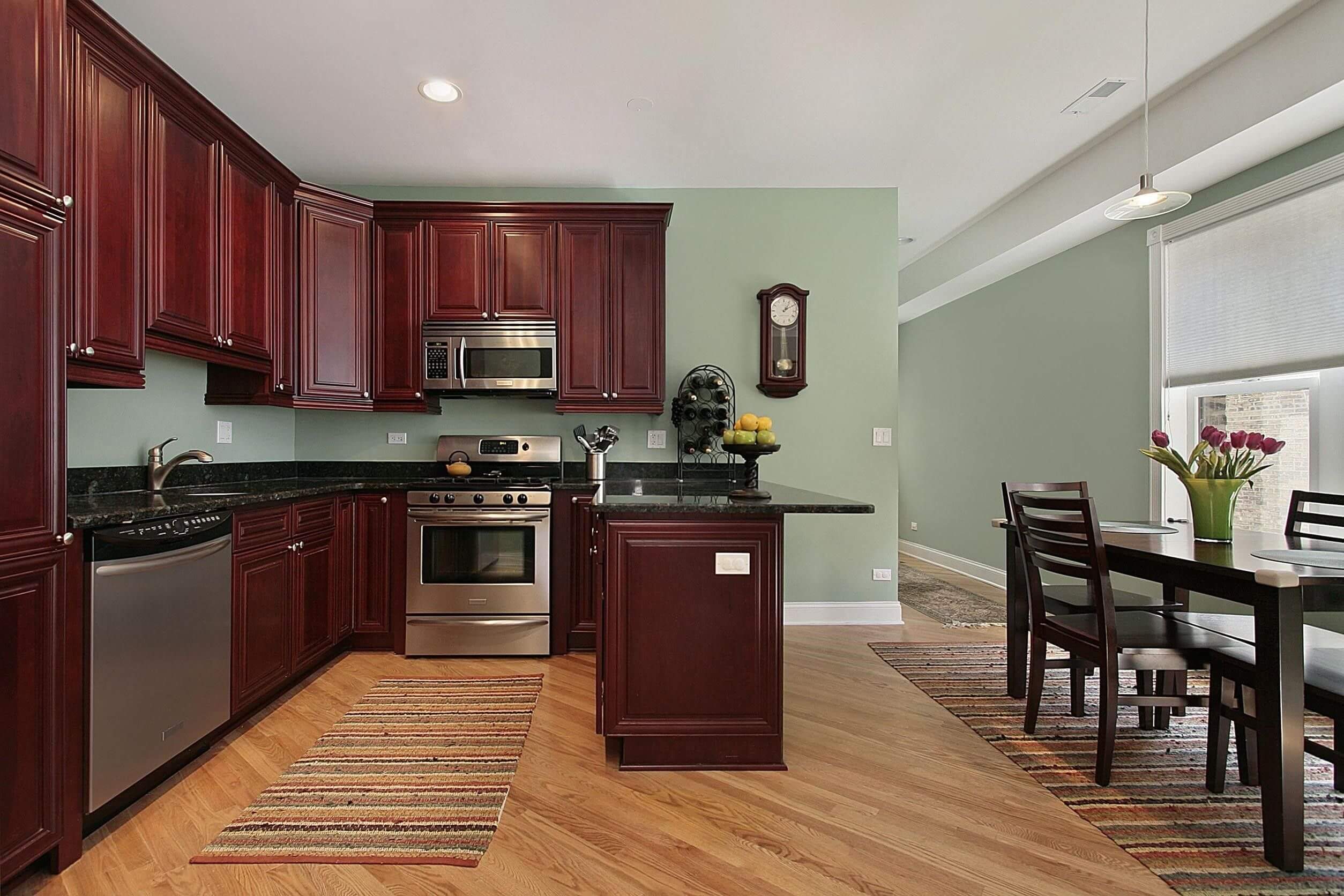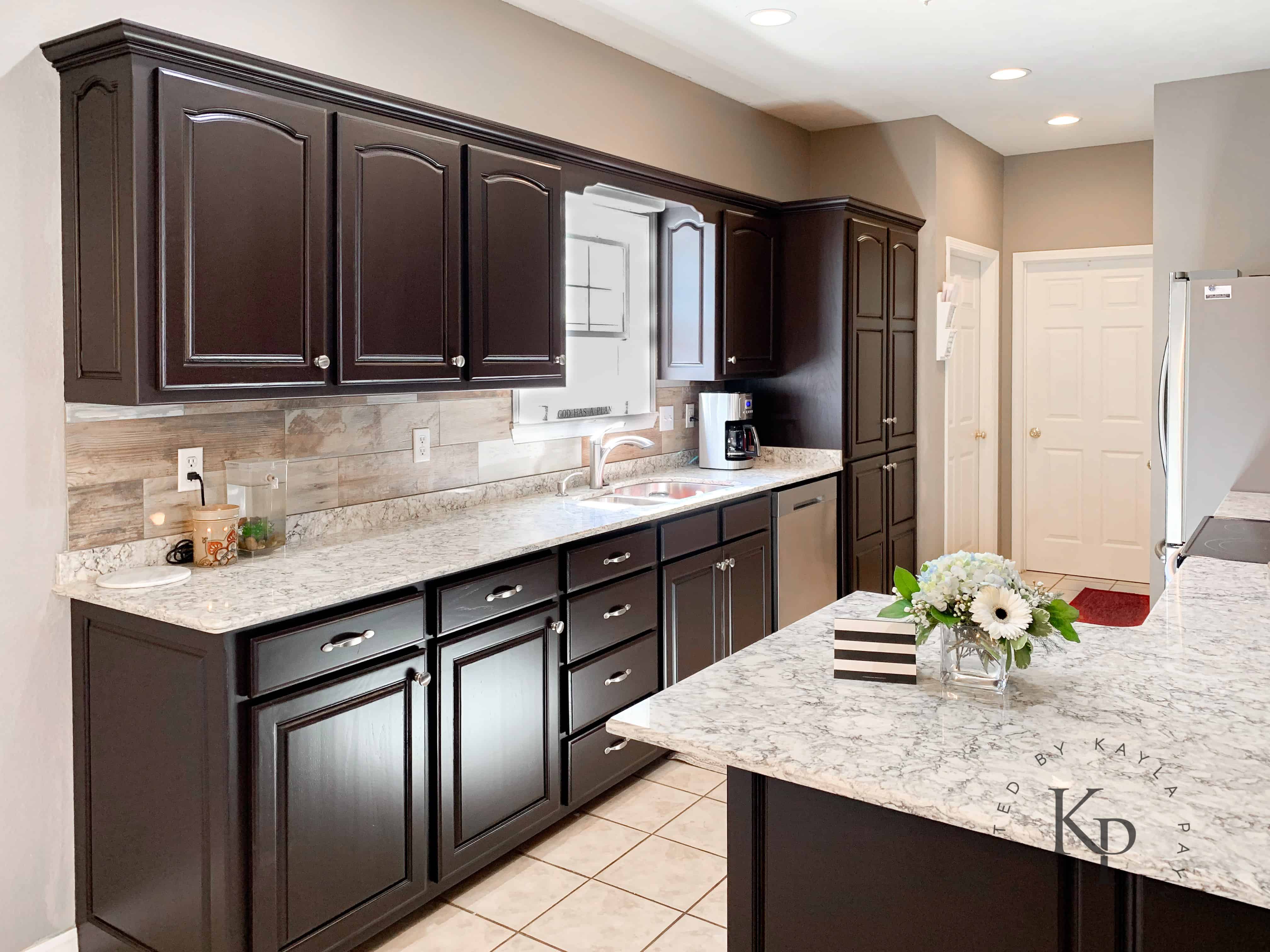Understanding the Impact of Dark Cabinets

Dark cabinets can dramatically influence a room’s overall feel, creating a sophisticated and dramatic ambiance. However, working with dark cabinets presents unique challenges, particularly regarding lighting and color selection.
The Influence of Dark Cabinets
Dark cabinets possess a powerful ability to shape a room’s atmosphere. They create a sense of depth and richness, adding a touch of elegance and formality. Dark cabinets are often associated with traditional or modern styles, but they can also be incorporated into eclectic and contemporary designs.
Challenges of Using Dark Cabinets
While dark cabinets offer aesthetic benefits, they also introduce certain challenges.
Lighting Considerations
Dark cabinets can absorb light, making a room appear smaller and darker. Proper lighting is crucial to counteract this effect.
- Overhead Lighting: Adequate overhead lighting is essential to illuminate the space and prevent a gloomy atmosphere. Consider using multiple light fixtures or a combination of overhead and ambient lighting.
- Under-Cabinet Lighting: Installing under-cabinet lighting can effectively illuminate the countertops and work areas, providing task lighting and adding a layer of visual interest.
- Accent Lighting: Strategic placement of accent lighting can highlight specific features, such as artwork or architectural details, and draw attention away from the darkness of the cabinets.
Color Selection
The color choices for walls, countertops, and backsplashes become more critical when working with dark cabinets.
- Wall Colors: Light and neutral wall colors create a sense of spaciousness and balance the darkness of the cabinets. Consider using white, cream, light gray, or soft pastels.
- Countertop Colors: Light-colored countertops, such as white quartz or marble, provide a striking contrast and brighten the space.
- Backsplash Colors: A backsplash with a light and reflective finish can help bounce light around the room and create a sense of depth.
Creating Different Moods and Styles
Dark cabinets can be used to achieve a wide range of styles and moods, depending on the overall design scheme.
Traditional Style
Dark wood cabinets are a classic element in traditional kitchens. They create a sense of warmth and elegance, often paired with ornate hardware and detailed molding.
Modern Style
Dark cabinets can also be incorporated into modern kitchens, where they create a sleek and sophisticated look. Consider using high-gloss finishes or metallic accents to enhance the contemporary feel.
Contemporary Style
In contemporary kitchens, dark cabinets can be used to create a bold statement. They are often paired with minimalist hardware and sleek countertops, creating a clean and sophisticated aesthetic.
Eclectic Style
Dark cabinets can also be used to add a touch of drama and intrigue to eclectic kitchens. They can be paired with a mix of textures and patterns, creating a unique and personalized space.
Choosing Complementary Paint Colors

Choosing the right paint color for your walls when you have dark cabinets is a key element in creating a harmonious and visually appealing space. A well-chosen color palette can enhance the beauty of your dark cabinets and create a balanced and inviting atmosphere. Understanding basic color theory is crucial in making informed decisions.
Understanding Color Relationships, Paint colors that go with dark cabinets
Color theory is a fundamental aspect of design that explores how colors interact and influence each other. Understanding the basics of color theory can help you create a balanced and visually appealing space.
The color wheel is a visual representation of color relationships. It is a circular arrangement of colors, with primary colors (red, yellow, and blue) at the top and secondary colors (orange, green, and purple) in between. Tertiary colors are created by mixing a primary color with a neighboring secondary color.
Colors are categorized based on their temperature: warm colors (red, orange, yellow) evoke feelings of energy and warmth, while cool colors (blue, green, purple) create a sense of calmness and tranquility. Complementary colors are located opposite each other on the color wheel and create a high contrast, making each color appear more vibrant. Analogous colors are located next to each other on the color wheel and create a harmonious and balanced look. Triadic colors are three colors that are equally spaced on the color wheel, providing a sense of visual balance.
Popular Paint Color Palettes for Dark Cabinets
Here are some popular paint color palettes that complement dark cabinets, along with examples of room styles they can enhance:
| Color Palette Name | Dominant Wall Color | Accent Colors | Examples of Room Styles |
|---|---|---|---|
| Classic White | White | Black, Gray, Silver | Modern, Contemporary, Minimalist |
| Warm Neutrals | Cream, Beige, Light Gray | Gold, Bronze, Copper | Traditional, Farmhouse, Rustic |
| Cool Neutrals | Pale Blue, Light Green, Soft Gray | Silver, Teal, Aqua | Coastal, Scandinavian, Modern Farmhouse |
| Bold and Bright | Deep Blue, Emerald Green, Mustard Yellow | White, Black, Gold | Mid-Century Modern, Eclectic, Art Deco |
Breakdown of Color Palettes
- Classic White: A timeless and versatile choice, white walls create a clean and spacious feel, allowing the dark cabinets to be the focal point. Black, gray, and silver accents add a touch of sophistication and contrast. This palette is ideal for modern, contemporary, and minimalist styles.
- Warm Neutrals: Cream, beige, and light gray walls create a warm and inviting atmosphere, complementing the rich tones of dark cabinets. Gold, bronze, and copper accents add warmth and elegance, perfect for traditional, farmhouse, and rustic styles.
- Cool Neutrals: Pale blue, light green, and soft gray walls create a calming and serene ambiance, enhancing the beauty of dark cabinets. Silver, teal, and aqua accents add a touch of freshness and sophistication, suitable for coastal, Scandinavian, and modern farmhouse styles.
- Bold and Bright: Deep blue, emerald green, and mustard yellow walls add a dramatic and vibrant touch, creating a focal point and complementing the dark cabinets. White, black, and gold accents add contrast and sophistication, ideal for mid-century modern, eclectic, and art deco styles.
Creating Visual Balance: Paint Colors That Go With Dark Cabinets

Dark cabinets can create a dramatic and sophisticated ambiance, but they can also make a room feel heavy and closed-in. Achieving visual balance is crucial to prevent this and ensure a welcoming and harmonious space. This involves carefully selecting paint colors that complement the dark cabinets and strategically incorporating lighter accents to brighten the space without overwhelming the dark elements.
Incorporating Lighter Accents
Using lighter paint colors on the walls and ceilings can create a sense of spaciousness and balance the darkness of the cabinets. The key is to choose colors that complement the cabinets without clashing or creating a stark contrast. Consider using warm, earthy tones, such as cream, beige, or light gray, which provide a calming and inviting atmosphere. These colors can also create a sense of depth and dimension, especially when paired with contrasting trim colors.
Light colors can visually expand the space, while dark colors can create a sense of intimacy and coziness.
Another technique for incorporating lighter accents is to use lighter furniture pieces, such as a light-colored sofa or dining chairs. This helps to break up the darkness of the cabinets and create a more balanced and inviting space.
For example, a living room with dark wood cabinets could be balanced by using a cream-colored sofa, a light-colored rug, and white walls. The light colors will create a sense of openness and spaciousness, while the dark cabinets will add a touch of sophistication and warmth.
Highlighting Specific Areas or Features
Strategic use of light and dark colors can be employed to highlight specific areas or features in a room with dark cabinets. For instance, a living room with dark cabinets could be made more dynamic by using a lighter paint color on the wall behind the fireplace, drawing attention to this focal point.
A light-colored accent wall can make a small space feel larger and create a sense of depth.
Conversely, a darker paint color could be used on a wall behind a bookshelf or a piece of art, creating a dramatic backdrop and emphasizing the featured element. This technique is particularly effective in rooms with high ceilings, where a darker color on the upper portion of the wall can create a sense of intimacy and coziness.
Paint colors that go with dark cabinets – When it comes to choosing paint colors that complement dark cabinets, there’s a wide range of options to consider. A popular choice for many homeowners are dark oak kitchen cabinets , which can create a warm and inviting atmosphere. These cabinets pair well with lighter hues, such as creams, whites, and soft pastels, which help to brighten the space and create a sense of balance.
While lighter hues like white and cream offer a classic contrast, bolder choices like warm yellows and deep greens can also complement dark cabinets. For those seeking a sophisticated and timeless aesthetic, behr dark navy cabinets pair beautifully with cool grays and soft blues, creating a calming and inviting atmosphere.